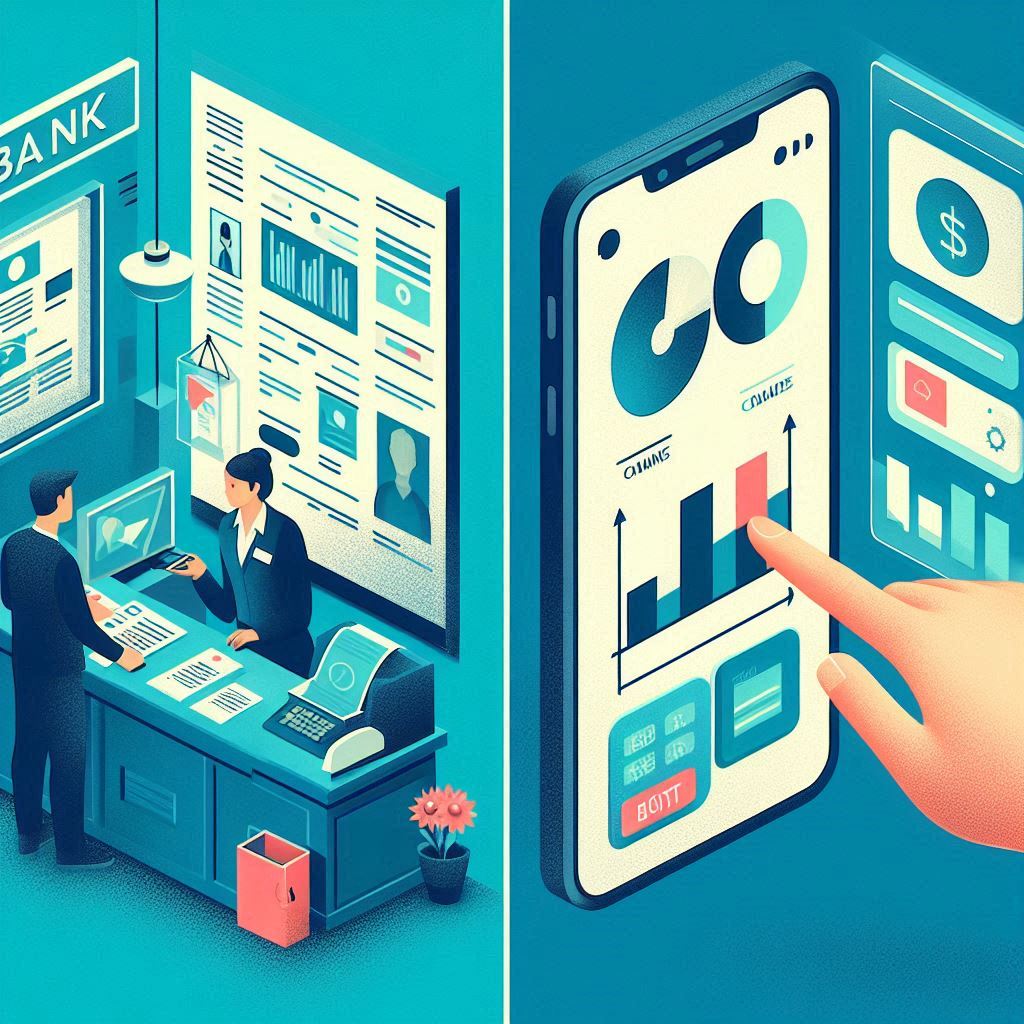Traditional Banks vs Digital Banks: Pros and Cons

Introduction
With the rapid advancement of technology, the banking industry has experienced a massive transformation. While traditional banks have been around for centuries, digital banks are quickly gaining popularity due to their convenience and innovation. As the financial landscape evolves, consumers are left with the decision: should they stick with their familiar traditional bank, or make the leap into the world of digital banking?
In this article, we will explore the key differences between traditional and digital banks, weigh the pros and cons of each, and help you decide which banking model suits your needs best.
Traditional Banks vs Digital Banks: A Comparison
| Feature | Traditional Banks | Digital Banks |
|---|---|---|
| Physical Presence | Yes, local branches and ATMs | No, entirely online |
| Accessibility | Limited by branch hours | 24/7 access via mobile app/website |
| Fees | Higher fees, including maintenance and ATM charges | Lower fees, often no monthly charges |
| Customer Service | In-person support available | Customer support via chat or phone |
| Security | Well-established security protocols | Advanced tech-driven security, such as multi-factor authentication |
| Loan Offerings | Personal, auto, home loans available | Limited loan products, often personal loans |
| Interest Rates | May offer competitive rates, depending on the product | Often higher rates on savings and lower rates on loans |
Understanding the Basics of Traditional Banks and Digital Banks
Traditional banks are the brick-and-mortar institutions that most people have been familiar with for years. They offer a wide range of services, from savings and checking accounts to mortgages and investment advice. The key defining feature of traditional banks is their physical presence—they have branches and ATMs where customers can go to manage their finances in person.
On the other hand, digital banks, also known as online banks or neobanks, operate entirely online with no physical branches. They provide similar services to traditional banks but focus on digital access and often have lower fees. Digital banks leverage technology to deliver banking services efficiently, offering a seamless user experience through mobile apps and websites.
Pros of Traditional Banks
Traditional banks have a longstanding presence and are trusted by many consumers for their stability and full-service offerings. Here are some of the advantages of sticking with a traditional bank:
- Physical Branch Access: One of the key benefits of a traditional bank is the ability to visit a physical branch. If you need face-to-face assistance or prefer in-person transactions, this can be incredibly convenient.
- Comprehensive Services: Traditional banks offer a wide range of financial products, including mortgages, auto loans, business accounts, and investment services. Many banks also provide specialized services like wealth management or financial planning, which might not be available at digital banks.
- Trust and Stability: Established traditional banks have decades, if not centuries, of history. This reputation often translates into a sense of security and trust for consumers, especially those who may be hesitant to switch to a digital bank.
- Established Customer Service: In-person customer service is often a big plus for those who prefer face-to-face interactions. Whether it’s opening an account, seeking financial advice, or resolving an issue, visiting a bank branch can sometimes be a more personal and reassuring experience.
Cons of Traditional Banks
While traditional banks have their advantages, there are also a few drawbacks to consider:
- Higher Fees: Traditional banks often charge higher fees for account maintenance, overdrafts, and ATM usage. Additionally, some banks may impose minimum balance requirements to avoid fees, which can be burdensome for those who don’t keep large balances in their accounts.
- Limited Accessibility: Traditional banks have limited access compared to digital banks. If you need to access your account outside of regular banking hours, you may be limited to ATMs or online banking features. However, this can be an inconvenience compared to the 24/7 accessibility of digital banking.
- Time-Consuming Processes: Banking at a traditional institution often requires waiting in line or making appointments for certain services. This can be time-consuming and inconvenient, especially for customers who prefer quick, on-the-go access.
- Geographic Restrictions: If you’re traveling or living in a different location, accessing services like in-person assistance can become a challenge. While online banking is accessible worldwide, the physical branches of traditional banks are often limited to specific regions or countries.
Pros of Digital Banks
Digital banks are revolutionizing the banking experience, offering a host of benefits that appeal to tech-savvy individuals. Let’s take a look at some of the top advantages of digital banks:
- Lower Fees: One of the biggest draws of digital banks is their lower fees. Many digital banks charge little to no monthly maintenance fees and have fewer charges for ATM withdrawals, making them a cost-effective alternative to traditional banking.
- Convenient 24/7 Access: With digital banks, you have 24/7 access to your accounts and banking services. Whether you’re at home, traveling, or on the go, you can check balances, transfer funds, and make payments anytime, anywhere.
- Innovation and Tech-Driven Features: Digital banks are often at the forefront of technological innovation. Features such as budgeting tools, instant payment notifications, and real-time spending insights can help users manage their finances more effectively.
- Simplicity and User-Friendly Apps: Digital banking apps are designed to be intuitive and easy to use, often simplifying complex tasks like transferring funds, setting up automatic payments, or investing. Many digital banks also offer personalized features to help users track their spending and save money.
Cons of Digital Banks
While digital banks offer many advantages, they are not without their downsides:
- Lack of Physical Presence: The most obvious drawback of digital banks is the lack of physical branches. If you prefer face-to-face banking or need assistance with complex transactions, this could be a significant inconvenience.
- Limited Product Offerings: While digital banks typically provide essential services like checking and savings accounts, they may not offer the same breadth of products as traditional banks. Services like mortgages, business loans, or investment products are often limited.
- Technology Dependence: Digital banks rely heavily on technology, which means that a stable internet connection or mobile device is required to access your account. If you experience a technical issue or lose access to your device, you may not be able to manage your finances until the problem is resolved.
- Customer Support Challenges: Although digital banks offer customer support via phone, email, or chat, the lack of in-person support can be a challenge for some users. If you prefer face-to-face interaction, the lack of a physical branch can feel impersonal.
Which One Should You Choose?
Ultimately, the choice between a traditional bank and a digital bank depends on your personal preferences and banking needs. Consider these factors before making your decision:
- If you prefer in-person banking and need access to a wide range of financial products, a traditional bank may be the better option for you.
- If you’re tech-savvy, want lower fees, and value 24/7 access to your accounts, a digital bank might be the way to go.
It’s also worth considering the possibility of using both. Many people choose to have an account with a traditional bank for their loans or investment needs while using a digital bank for everyday transactions.
Conclusion
As banking continues to evolve, the decision between traditional banks and digital banks becomes increasingly important. Traditional banks offer a sense of security, in-person support, and a wide range of services, while digital banks offer convenience, lower fees, and cutting-edge technology. Ultimately, the choice depends on your individual preferences and banking requirements. By understanding the pros and cons of each option, you can make an informed decision that aligns with your financial goals.
FAQ Section
1. Are digital banks safe to use?
Yes, digital banks are generally very safe to use. They implement strong security measures such as multi-factor authentication, encryption, and fraud detection systems to protect your personal information.
2. Can I get a loan from a digital bank?
Many digital banks offer personal loans, but they may not provide the same variety of loan products (like mortgages or business loans) as traditional banks.
3. Do digital banks charge fees?
While digital banks typically charge lower fees compared to traditional banks, some may still charge fees for certain services. Be sure to read the fine print before opening an account.
4. Can I transfer money from a digital bank to a traditional bank?
Yes, you can transfer money from a digital bank to a traditional bank using wire transfers or other methods like ACH payments.
5. Can I access my digital bank account if I don’t have internet access?
No, digital banking requires an internet connection to access your account. If you experience internet connectivity issues, you may not be able to use your digital bank services.
Final Review
In conclusion, both traditional and digital banks offer distinct advantages and disadvantages. Consider your preferences, banking needs, and lifestyle when choosing the best option for you. Whether you prefer the security and personal touch of a traditional bank or the convenience and low fees of a digital bank, there’s an option to fit your financial needs.


